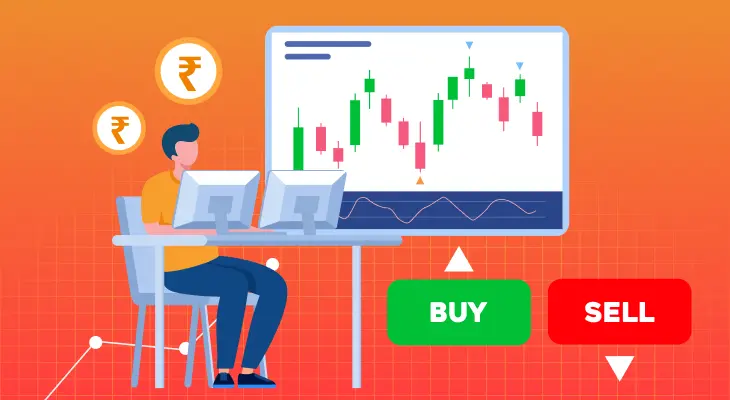
Table of content
How to Trade in Futures and Options
Getting involved in Futures and Options (F&O) trading entails venturing into a distinct segment of the stock market that is more complex than traditional stock trading. It involves working with derivatives, which are assets that do not now have a value but rather indicate what they may cost in the future.
It's important to grasp the fundamentals of F&O trading if you're new to the world of finance. A specific understanding of diverse F&O methods, put and call option types and fundamental and technical analysis is required for this type of trading.
The purpose of this blog is to assist in reducing the confusion associated with F&O trading. Whether you're just starting out or looking to improve your trading skills, We'll explain how to trade futures and options, break down the distinctions between them, and highlight key points to keep in mind.
F&O Unveiled: Navigating the Complexities
As you venture into the world of trading in Futures and Options (F&O), it's essential to demystify some fundamental concepts. Unlike direct stock trading, derivatives lack a present value but instead represent the future price of underlying assets. Think of it as predicting the future value of gold, stocks, or bonds. This segment, known as F&O, is a bit like placing bets on where these asset prices are headed.
To grasp F&O trading, start by understanding its foundation, which includes concepts like fundamental analysis, technical analysis, F&O strategies, and different put and call options. Don't worry if this sounds like a lot; we'll break it down for you, making the journey into F&O trading from tier-2 cities as smooth as possible.
Understanding the Differences: Futures vs. Options
Futures and Options both play important roles in the derivatives market, although they do so in distinct ways. Consider futures as a contractual commitment that binds both the buyer and seller to trade at a predetermined value of the underlying asset. It's similar to making an agreement to purchase and sell assets at a specific time and price.
Unlike futures, options provide the buyer with a choice rather than an obligation. It's equivalent to having the authority to approve or reject a transaction. When a buyer joins into an Options contract, they get the right, but not the duty, to trade at a set price.
To make things simpler, if you're a transport firm concerned about unexpected fuel price volatility, you may use Futures contracts to lock in a fixed price. On the other hand, a seller may utilise options contracts to hedge against unexpected fuel price decreases. The primary participants here are the companies that deal with gasoline. They settle on a price, quantity, and delivery date, assuring their financial future.
Unveiling the Derivatives Jargon
-
Call Option:
Consider this your right to purchase an item at a certain price before a specified date. -
Put Option:
This is the right to sell an asset at a specified price before a specific date. -
Spot Price:
This is just the current market price of the asset you're considering. -
Strike Price:
Consider this the agreed-upon price for future purchases or sales. -
Expiry Date:
This is similar to the deadline for your Options contract, which is normally the last Thursday of each month. -
Premium:
The non-refundable amount you pay for the privilege of owning an Options contract.
A Step-by-Step Guide for How to Trade in F&O
Let's go over the procedure of trading futures and options. The path may appear difficult at first, but with a step-by-step approach, you'll find it more manageable.
-
Step 1: Setting the Stage
To begin your F&O adventure, open a trading account with a registered broker on the BSE or NSE. This account is your passport to the fascinating world of futures and options. -
Step 2: Portal Exploration
Login to m.Stock app or Web. -
Step 3: Research and Choice
Research the various futures and options in the same way that you would plan for a trip. Determine what is compatible with your comfort level and financial goals. This step is critical to ensuring a smooth voyage ahead. -
Step 4: Placing Your Order
After making an informed selection, enter the order information. You're now ready to buy futures and options at the strike price that correspond to your preferred path—whether it's a call option for a predicted increase or a put option for an expected decline. -
Step 5: Understanding Outcomes
Consider these possible outcomes as milestones along the way: -
Offsetting the Position:
Selling the option contract before it expires may result in a profit or loss. -
Exercising the Option:
You can execute the option when conditions are favourable, such as when the price of the underlying asset exceeds the strike price. -
Expiration Worthlessness:
Options contracts become worthless if the underlying asset's price does not fulfil the strike price criteria.
Factors to Consider
-
Risk Management:
Manage your risk in F&O by recognising the restrictions imposed by the premium amount. These limits limit your possible profits. -
Margin Dynamics:
Market volatility can disrupt your financial path. Prepare for growing Future margins at such periods to avoid being stuck without enough resources. -
Profit Targets and Stop Losses:
Establish certain milestones for your financial path. Implement stop losses to function as emergency brakes, reducing prospective losses. Your profit objectives dictate when to end the adventure, guaranteeing a successful financial outcome. -
Trader Mindset:
Approach futures and options trading as you would any other endeavour. Focus on safeguarding your principal capital by establishing defined profit and loss criteria for each deal. Consider it like safeguarding your possessions during a journey. -
Cost Analysis:
Consider brokerage fees, statutory costs, and stamp duty as tolls on your financial highway.
Conclusion
Trading in F&O may appear difficult, but with the fundamentals in your toolkit, you're well-equipped. Remember the distinctions between futures and options, the importance of strike prices, and how market dynamics influence trading.
In this changing industry, expertise is essential. This blog is only the beginning; each deal is a step forward, helping you gain confidence and skill. Take it slowly, absorb the knowledge, monitor the market, and refine your skills. Becoming an F&O specialist is an ongoing journey. The market may have its challenges, but equipped with information and curiosity, you are prepared to navigate.




